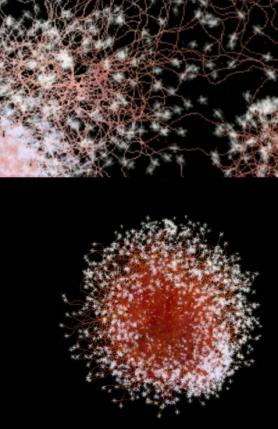 Joseph Nechvatal's Computer Virus Project
Joseph Nechvatal's Computer Virus Project
Balancing Art and Complexity: Joseph Nechvatal's Computer Virus Project
by Stéphane Sikora
Introduction
Since his first robotic-assisted paintings in 1986, the artist Joseph Nechvatal has always questioned the relationship between reality and virtuality. By working in-between these two spaces, Nechvatal has shown their complex interaction. This reciprocity is what Nechvatal sees as typical of viractualism, an art theory term he developed in 1999. This term viractualism (and viractuality) emerged out of his doctoral research into the philosophy of art and new technology concerning immersive virtual reality at Roy Ascott's Center for Advanced Inquiry in the Interactive Arts (CAiiA), at the University of Wales College, Newport, UK. There he developed this viractual concept, which strives to identify and create an interface between the biological and the technological. Viractualism is central to his work as an artist. [Nechvatal, 2011]
The basis of the viractual conception is that virtual producing computer technology has become a noteworthy means for making and understanding contemporary art. This brings art to a place where one finds the emerging of the computed (the virtual) with the uncomputed corporeal (the actual). This amalgamate is what he calls the viractual. Digitization is a key metaphor for viractuality in the sense that it is the elementary translating procedure today. For Nechvatal, the viractual recognizes and uses the power of digitization while being culturally aware of the values of monumentality and permanency - qualities that can be found in some compelling analog art. [Nechvatal 2011]
The Computer Virus Project's initial goal was to produce physical paintings by using algorithms implementing «viral» processes. It is based on a simulation tool which allows Nechvatal to virtually introduce artificial organisms into a digitized reproduction of an earlier work of his, and let them transform and destroy that original image. During these « attacks », novel still images can be extracted and painted on canvas, which is a way to realize them; i.e. to bring back the virtual into the real.
After an historical presentation of the Computer Virus Project, this paper will describe the simulation model in detail, and how we attempted to reconcile art with random exploration and complex processes.
1 Origin of the project
Following his first series of innovative paintings that were created using a digital-robotic painting machine in 1986, Nechvatal sought to create paintings around the concept of the computer virus. He developed this idea by considering an image as a host for the viruses: active agents whose role it is to manipulate and degrade the information contained in the image. The negative connotations of the HIV virus as a vector of disease is reflected in the principle of degradation of the image. But here, the virus is also the basis of a creative process, producing newness in reference to the major influence of the virus on evolution in biological systems.
continue reading here:
http://www.eyewithwings.net/nechvatal/Balancing/Balancing%20Art%20and%20...